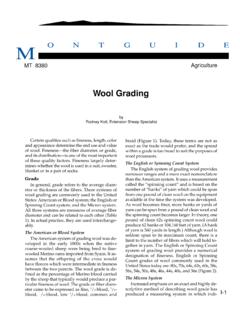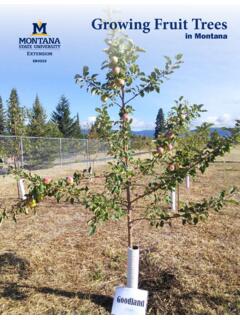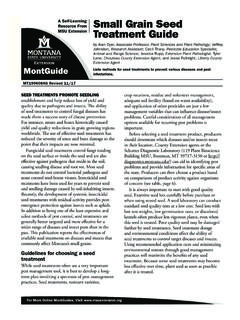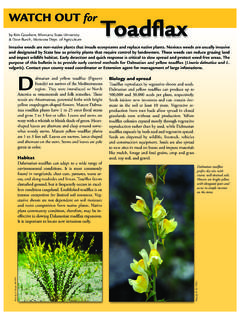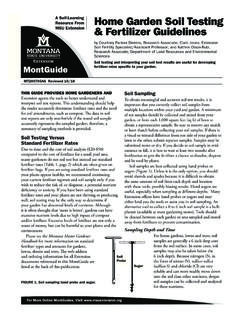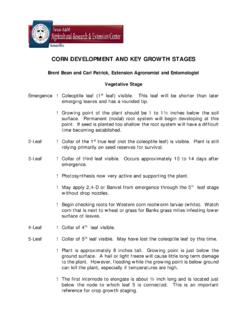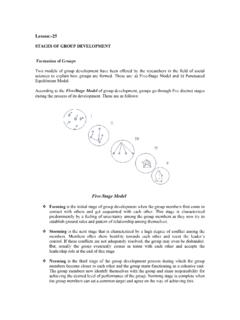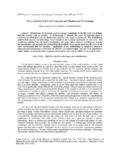Transcription of Using Growing Degree Days to Predict Plant Stages
1 MontGuideFor More Online MontGuides, Visit MT200103AG Reprinted 7/18 Using Growing Degree Days to Predict Plant Stagesby Perry Miller, MSU Assistant Professor, Will Lanier, IPM Assistant, and Stu Brandt, Ag Canada agronomistIt s tough to Predict Plant growth based on the calendar because temperatures can vary greatly from year to year. Instead, Growing Degree days, which are based on actual temperatures, are a simple and accurate way to Predict when a certain Plant stage will occur. Plant DEVELOPMENT DEPENDS ON TEMPERATURE.
2 Plants require a specific amount of heat to develop from one point in their lifecycle to another, such as from seeding to the four-leaf often use a calendar to Predict Plant development for management decisions. However, calendar days can be misleading, especially for early crop growth Stages . For example, a cool May can greatly delay a Plant reaching the four-leaf stage , which affects optimal weed control tactics. Or two weeks of hotter-than-normal July weather can advance lentils from green pod to harvest-ready, meaning you should have had the combine in the field three days ago!
3 Research has shown that measuring the heat accumulated over time provides a more accurate physiological estimate than counting calendar ability to Predict a specific crop stage , relative to insect and weed cycles, permits better management. This is especially important when three or more crops are being grown on the same farm, each with a different management schedule for pesticide application, fertility management and harvest. Degree day calculationsThough temperatures often average out from year to year over an entire Growing season, there are usually cooler- or warmer-than-normal times during significant parts of the Growing season.
4 As the saying goes, normal weather is an average of extremes. Warmer-than-normal days advance the Plant and insect growth rapidly, while cooler-than-normal days slow them. Growing Degree days (abbreviated GDD or DD) is a way of assigning a heat value to each day. The values are added together to give an estimate of the amount of seasonal growth your plants have achieved. Degree days are easy to calculate: Add each day s maximum and minimumtemperatures throughout the Growing season, divide that sum by two to get an average, and subtract the temperature base assigned to theplant you are monitoring.
5 (Temperature base is thetemperature below which Plant development stops).The resulting thermal time more consistently predicts when a certain Plant stage will occur. When summed together, these thermal times are sometimes referred to as a thermal calendar. Figure 1 (page 2) illustrates the relationship between time, temperature and the accumulation of Degree days. One Degree day is one day when the average daily temperature is at least one Degree above the lower developmental threshold (the temperature below which development stops).
6 For example, if the low for the day was 33 F and the high was 67 F, then the day had an average temperature of 50 F. If a Plant had a temperature base of 32 F, like wheat does, then that day counts as 18 DD on the Fahrenheit scale (67 + 33 / 2 - 32 = 18).This research on Plant growth stage response to Growing Degree days was completed in the mid 1990s at two locations in semiarid Saskatchewan by Perry Miller and Stu Brandt, research scientists at that time with Agriculture and Agri Food Canada. This has been by far the most popular Extension article in Perry Miller s career at MSU.
7 This type of information is rarely collected in such a comprehensive manner and Plant species growth rates are a highly conserved aspect, with only minor variation due to cultivar differences. Thus, this information is expected to be somewhat timeless . In 2018, we initiated a 3 year follow up study in Bozeman that will provide additional information on Plant specific growth Table 1 (page 4) shows the Growing Degree days required to reach various Plant Stages for several crops. The range in reported GDD values encompasses 95 percent of the observations taken at two sites in Saskatchewan.
8 Many locations in Montana offer a running tally of Degree days, allowing accurate tracking of Plant and insect development. The web site has a Degree day report, and the report is also published in the Montana Crop Health Report available from the MSU Entomology Department for a small Degree daysEach developmental stage of an organism has its own total heat requirement. Development can be estimated by accumulating Degree days between the high and low temperature thresholds throughout the season. The date to begin accumulating Degree days, known as the biofix date, varies with the species.
9 Biofix dates are usually based on specific biological events such as planting dates or first occurrence of a pest. Accumulation of Degree days should be done regularly, especially when a control action decision is questions and answersWhat are Degree days and what are they used for? Degree days are commonly used in agriculture and natural resources management to Predict events and schedule management activities, such as when to sample or control a is a biofix?A biofix is the date to start accumulating Degree days for a particular Plant .
10 Examples are the first date a weed seedling is observed or the date tree buds start to break. Degree days are reset to zero at the biofix date, no matter how many were accumulated before do I interpret Degree day calculations? Degree days can take some of the calendar variations out of predicting events influenced by temperature. For example, compare a growth stage calculation Using calendar days and Degree days: The fifth-leaf stage of wheat occurs either at an average of 21 calendar days after germination or 350 Degree days after germination.

